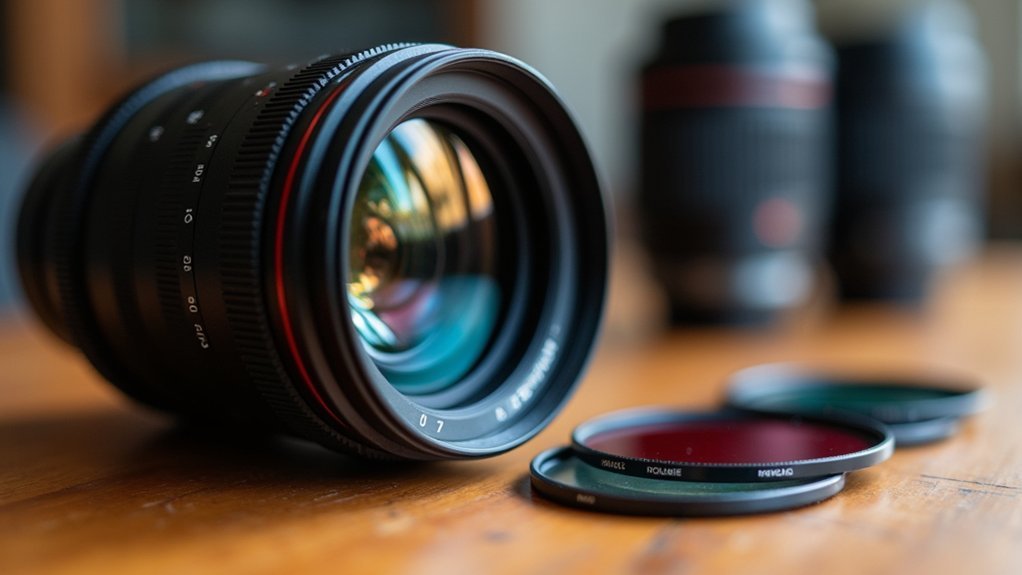The main lens correction types include spherical aberration (causing focus point variation), chromatic aberration (color fringing), astigmatism (asymmetric focusing), field curvature (uneven focus plane), and distortion (geometric inaccuracies). You’ll find corrections through specialized lenses like aspherical elements and apochromatic designs, or via digital post-processing with software tools. For microscopy, additional corrections include flatfield, phase contrast, and DIC systems. Understanding these correction types helps you achieve clearer, more accurate images in any optical situation.
Understanding Aberrations in Microscope Optics

When you’re examining specimens under a microscope, the quality of your image depends largely on how well the optical system manages aberrations. These optical imperfections cause deviations from ideal imagery, affecting clarity and precision in your observations.
Common aberrations include spherical aberration, where light rays focus at different points, and chromatic aberration, which produces color fringing as wavelengths refract differently.
Optical perfection requires overcoming spherical and chromatic aberrations that distort focus and introduce unwanted color variations.
You’ll notice astigmatism when the lens fails to focus light to a single point, making lines appear sharper in one direction than another.
Field curvature creates an uneven focus plane, leaving edges blurry while the center remains sharp.
Distortion affects geometric accuracy, causing straight lines to appear bent—either inward (barrel) or outward (pincushion). This can be particularly problematic when your work requires precise measurements.
Spherical Aberration Correction in Objective Lenses
Spherical aberration correction in modern objective lenses employs Edge Sharpness Technology to guarantee light rays converge at a single focal point, regardless of their path through the lens.
You’ll find aspherical elements greatly improve image quality by precisely adjusting the lens curvature to compensate for edge distortion effects.
These advancements in focusing accuracy enable your microscope to render crisp, detailed images with enhanced contrast and resolution.
Edge Sharpness Technology
The pursuit of perfect optical clarity drives lens manufacturers to combat spherical aberration—one of photography’s most persistent challenges. When light rays enter a lens at varying distances from the optical axis, they focus at different points, degrading image quality, particularly at the edges.
Edge sharpness technology tackles this issue through optimized lens curvature and specialized coatings that enhance light transmission while reducing distortion.
Modern lens correction incorporates aspherical elements that guarantee all light rays converge at the same focal point, dramatically improving corner-to-corner clarity.
You’ll find today’s high-performance lenses utilize computer-aided design to refine their optical profiles. The effectiveness of these improvements can be measured through MTF curves, which quantify a lens’s ability to resolve fine details across the entire frame.
Aspherical Element Benefits
While conventional lenses struggle with edge clarity, aspherical elements represent a revolutionary approach to correcting spherical aberration. These specialized components feature non-uniform curvatures that dramatically enhance optical performance throughout your entire field of view.
You’ll notice the difference aspherical elements make immediately—sharper images with improved contrast, particularly in challenging low-light conditions. By minimizing edge distortion that plagues traditional spherical lenses, your photos maintain clarity from center to corner.
The benefits extend beyond image quality. Manufacturers can create more compact, lighter lenses while maintaining superior performance. This design efficiency often reduces the total elements needed in construction, potentially lowering costs without sacrificing results.
That’s why today’s premium lenses, whether wide-angle or telephoto, frequently incorporate aspherical elements—they’re essential for professionals demanding exceptional image reproduction.
Focusing Accuracy Improvements
Accurate focusing depends critically on how well your lens corrects for spherical aberration, a fundamental challenge in optical design.
When light rays can’t converge at a single focal point, your images lose sharpness and detail. Modern lens corrections tackle this problem through sophisticated engineering.
- Aspheric lens designs vary curvature across the surface, ensuring all light rays reach the same focal point.
- Multi-element constructions combine different glass types to minimize aberrations while maintaining compact size.
- Advanced optical coatings reduce aberration effects while enhancing light transmission and contrast.
- Modulation Transfer Function (MTF) measurements quantify the effectiveness of spherical aberration correction.
These innovations dramatically improve image clarity in today’s objective lenses.
You’ll notice the difference particularly in challenging lighting conditions where uncorrected spherical aberration would otherwise compromise your results.
Chromatic Aberration Compensation Techniques
Chromatic aberration manifests as color fringing that you’ll notice most prominently around high-contrast edges in your images.
You can tackle lateral CA effectively using color-specific sliders in editing software, adjusting red/cyan and blue/yellow fringing until the unwanted colors disappear.
For more stubborn axial chromatic aberration, you’ll need specialized digital correction algorithms that target problem areas while carefully preserving image quality in the process.
Color Fringing Solutions
Since photographers often encounter color fringing in high-contrast areas, mastering chromatic aberration correction techniques is essential for professional-quality images.
You’ll need to distinguish between lateral and axial chromatic aberrations to apply the right solution, as they affect your images differently.
When tackling color fringing, follow these proven approaches:
- Start by applying noise reduction before addressing chromatic aberrations to maintain overall image quality.
- Use red/cyan and blue/yellow adjustment sliders to correct lateral CA, focusing first on high-contrast edges near corners.
- Take advantage of automated lens correction profiles in RAW development software that adjust for your specific lens’s optical power.
- Exercise caution with axial CA correction, as aggressive adjustments can deteriorate other image quality aspects.
Remember that lateral CA is easier to fix, while axial aberrations require more finesse.
Digital Correction Algorithms
Digital correction algorithms represent the backbone of modern chromatic aberration removal, transforming what was once a major optical limitation into a manageable post-processing task.
These algorithms specifically target the two main types of chromatic aberration: lateral (transverse) and axial (longitudinal).
For lateral aberration, you’ll find adjustment sliders for red/cyan and blue/yellow that effectively eliminate color fringing around high-contrast edges. This type responds particularly well to digital correction.
Axial aberration proves more challenging, requiring careful adjustments to avoid compromising other image qualities.
Most modern RAW processing software simplifies this process with pre-calibrated lens profiles that automatically apply the appropriate corrections.
Adobe Camera RAW and Lightroom, for example, can instantly analyze and fix chromatic aberration issues based on your specific lens characteristics, saving you considerable time during post-processing.
Flatfield Correction for Even Illumination

When capturing images with wide-angle lenses, you’ll often notice darker corners and edges compared to the center of your frame—a phenomenon known as vignetting.
Flatfield correction addresses this issue by compensating for uneven illumination across your image, ensuring consistent brightness levels throughout.
To achieve ideal results with flatfield correction:
- Create a reference image of a uniform surface to identify brightness variations
- Apply corrections either in-camera or during post-processing
- Focus on wide-angle lenses where peripheral light drop-off is most pronounced
- Utilize software that analyzes and adjusts brightness patterns across the frame
Plan Apochromatic Objectives: The Gold Standard
Plan apochromatic objectives eliminate chromatic aberration across three wavelengths, giving you unparalleled color accuracy in your microscopy work.
You’ll notice considerably higher resolution capabilities due to their advanced optical design and numerical apertures typically exceeding 1.0.
Their superb color fidelity makes these objectives essential for applications requiring precise color reproduction, such as fluorescence microscopy and detailed biological imaging.
Chromatic Aberration Elimination
Among the various lens correction technologies available today, plan apochromatic objectives stand as the gold standard for eliminating chromatic aberration.
When you’re shooting high-contrast scenes, chromatic aberration creates distracting color fringes that diminish image clarity.
Plan apochromatic designs overcome this limitation through sophisticated engineering:
- Utilizes at least three different glass types working in harmony to correct wavelength dispersion
- Guarantees consistent focus across the entire image plane with flat field performance
- Dramatically reduces color fringing by aligning different wavelengths at the same focal point
- Combines multiple lens elements to achieve superior correction across the visible spectrum
You’ll notice the difference immediately in applications requiring precision, such as microscopy and astrophotography, where accurate color reproduction and fine detail preservation are essential for professional results.
Higher Resolution Capabilities
The pursuit of perfect image details finds its pinnacle in Plan Apochromatic Objectives, which deliver resolution capabilities approaching the theoretical limits of light diffraction. These advanced lenses utilize specialized low-dispersion glass elements to correct chromatic aberrations across three wavelengths, eliminating color fringing that would otherwise compromise image quality.
You’ll appreciate the superior optical performance that Plan APOs provide through their higher numerical aperture (NA), which enhances light-gathering capabilities and resolution, especially in challenging conditions.
| Feature | Benefit | Application |
|---|---|---|
| Flat field correction | Eliminates edge distortion | Whole-specimen analysis |
| High NA values | Maximum resolution | Fine structure imaging |
| Three-wavelength correction | True color reproduction | Fluorescence microscopy |
These objectives represent the ultimate distortion correction technology, ensuring consistent focus across your entire field of view.
Superb Color Fidelity
Beyond resolution capabilities, accurate color reproduction represents a fundamental challenge in optical systems that Plan Apochromatic objectives masterfully overcome.
When you’re utilizing these premium lenses, you’ll experience unparalleled color fidelity that’s essential for scientific research and professional photography.
Plan Apochromatic objectives achieve this exceptional performance through:
- Strategic incorporation of specialized low-dispersion glass that minimizes chromatic aberration across three wavelengths
- Advanced optical design that focuses red, green, and blue light to precisely the same point
- Multiple lens elements arranged to virtually eliminate color fringing and distortion
- Balanced correction that maintains color accuracy uniformly across the entire flat field of view
This remarkable color precision makes Plan Apochromatic objectives the gold standard for applications where accurate color representation is non-negotiable.
Phase Contrast Correction for Transparent Specimens
Viewing transparent specimens through conventional microscopes often yields disappointing results, as cellular structures with similar refractive indices appear virtually invisible to the naked eye.
Phase contrast correction solves this problem by transforming phase shifts in light into amplitude changes, making transparent specimens appear darker against a bright background.
You’ll find this technique invaluable when working with biological samples, particularly live cells that would be damaged by traditional staining methods.
The system uses a phase plate and annular diaphragm to create the contrast needed for high-resolution imaging of otherwise invisible structures.
Differential Interference Contrast (DIC) Systems

While phase contrast enhances transparent specimens by transforming phase shifts into visible amplitude changes, Differential Interference Contrast (DIC) systems take optical manipulation to another level.
Microscopy evolves from phase shifts to the sophisticated optical manipulation of DIC systems, revealing previously invisible cellular details.
The specialized lenses provide remarkable visual clarity for transparent biological samples without staining requirements.
DIC technology offers several key advantages:
- Uses polarized light beams that split and recombine to reveal refractive errors in specimens
- Creates three-dimensional appearances with stunning contrast enhancement
- Requires precise alignment of Wollaston prisms and optical components
- Displays color variations based on optical path differences, enriching available visual information
You’ll find DIC microscopy particularly valuable when examining living cells and tissues.
This sophisticated technique has become essential across cell biology, materials science, and nanotechnology fields where high-resolution imaging with minimal sample preparation is critical.
Fluorescence-Optimized Lens Corrections
As fluorescent materials emit light at different wavelengths than they absorb, specialized lens corrections become vital for capturing their true brilliance and detail.
Fluorescence-optimized lens corrections address common imaging issues like chromatic aberration and vignetting that can obscure your fluorescent signals.
These lens systems incorporate specialized coatings that enhance light transmission while minimizing unwanted reflections, greatly improving image quality and signal-to-noise ratios.
You’ll notice the difference particularly in microscopy, forensics, and medical diagnostics where precise fluorescence detection is essential.
When you’re working with fluorescent samples in biological research or other scientific applications, these corrections guarantee you’re seeing accurate representations of your specimens.
The result is clearer, more precise fluorescent imaging that allows for better analysis and interpretation of your data.
Oil Immersion Techniques for Resolution Enhancement

Oil immersion techniques represent a powerful advancement in resolution enhancement, taking microscopic imaging beyond what standard lenses can achieve alone.
By applying a special oil with a refractive index of approximately 1.5 between your specimen and objective lens, you’ll correct refractive errors that typically limit resolution in conventional microscopy.
Bridging the gap with high-index oil eliminates refractive barriers, unlocking microscopic details conventional lenses cannot capture.
- Considerably increases numerical aperture, allowing you to distinguish previously undetectable details
- Works ideally with high magnification objectives (100x or greater)
- Provides enhanced detail by minimizing light refraction at glass-air interfaces
- Requires proper application—too much oil causes contamination while too little reduces image quality
When properly implemented, oil immersion techniques can dramatically improve your microscope’s resolving power, letting you visualize fine structural details that would otherwise remain hidden.
This approach is particularly valuable when working with specimens requiring maximum clarity and definition.
Digital Post-Processing Correction Methods
Even when using high-quality lenses, various optical imperfections can compromise your images. Modern editing software offers powerful tools to address these issues through digital correction.
| Correction Type | Problem | Solution |
|---|---|---|
| Vignetting | Corner darkening | Brightness adjustment sliders (may increase noise) |
| Distortion | Barrel or pincushion warping | Geometric algorithms requiring slight cropping |
| Chromatic Aberration | Color fringing at high-contrast edges | Adjustment sliders for lateral and axial components |
You’ll find automated lens correction profiles in RAW development software like Adobe Camera RAW and Lightroom that apply pre-calibrated parameters specific to your lens model. These profiles simultaneously address vignetting, distortion, and chromatic aberration with minimal user intervention, dramatically improving image quality. For precise control, you can still manually adjust each correction type using dedicated sliders.
Balancing Correction Types With Budget Considerations

When steering through the world of lens corrections, you’ll need to carefully balance quality improvements against your financial constraints.
Prioritize essential lens correction types like distortion and chromatic aberration that deliver the most noticeable improvements without breaking the bank.
- Invest in software with automated lens correction profiles to reduce long-term costs and streamline your workflow.
- Choose lenses with superior inherent optical quality to minimize the need for extensive post-processing corrections.
- Focus your budget on corrections that impact your specific photography style the most.
- Regularly review whether your correction methods are cost-effective by evaluating their impact on your final images.
This strategic approach guarantees you’re making informed budget considerations while maintaining image quality, helping you achieve professional results without unnecessary expenses.
Specialized Corrections for Microscope Photography
Microscope photography demands a unique set of lens corrections to overcome the distinctive challenges presented at extreme magnifications. When shooting at microscopic levels, optical aberrations become markedly more pronounced, requiring specialized attention.
Apochromatic corrective lenses are specifically designed to minimize chromatic aberration by addressing multiple light wavelengths simultaneously, ensuring color accuracy in your specimens.
You’ll also need to apply distortion correction to maintain structural integrity, keeping straight lines properly aligned in your microscopic subjects.
Don’t overlook vignetting correction—uneven illumination can obscure critical details at the image periphery.
Many microscope photography setups now incorporate dedicated digital correction software with pre-calibrated profiles that automatically adjust for these common imperfections during post-processing.
These specialized tools help you achieve the clarity and precision essential for scientific documentation or analysis.
Frequently Asked Questions
What Are the Different Types of Correction Lenses?
You’ll find various correction lenses: single vision for one distance, bifocals with two zones, trifocals with three, progressives without visible lines, and contacts including disposable, RGP, and toric for astigmatism.
What Are the 3 Types of Frequently Used Lenses?
The 3 frequently used lenses are single vision (correcting one distance), bifocal (with two distinct powers), and progressive lenses (offering seamless progression between multiple focal points without visible lines). You’ll find each serves different needs.
What Are Lens Corrections?
Lens corrections are digital adjustments you’ll apply to fix optical imperfections in your photos. They eliminate distortion, chromatic aberration, and vignetting to improve image quality – making straight lines truly straight and colors more accurate.
What Types of Lens Is Used to Correct?
You’ll find various lenses to correct vision problems. Single vision lenses fix one distance issue, while bifocals, trifocals, and progressives address multiple viewing distances simultaneously with different focal points in one lens.
In Summary
You’ll find that different lens correction types address specific microscopy challenges. Whether you’re combating spherical aberration, chromatic artifacts, or field curvature, the right objective makes all the difference. Don’t overlook immersion techniques and digital post-processing as valuable correction methods. Balance your correction needs with your budget, and you’ll achieve the ideal imaging results for your specific microscopy applications.





Leave a Reply